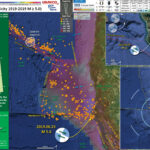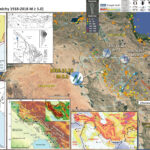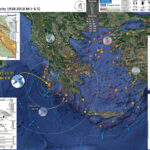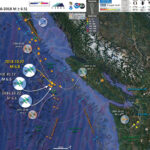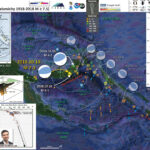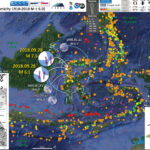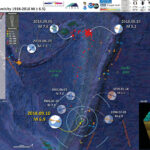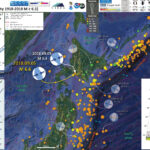Well, I was on the road for 1.5 days (work party for the Community Village at the Oregon Country Fair). As I was driving home, there was a magnitude M 5.6 earthquake in coastal northern California. https://earthquake.usgs.gov/earthquakes/eventpage/nc73201181/executive I didn’t realize…
Earthquake Report: Iran
This morning (my time) there was a possibly shallow earthquake in western Iran with a magnitude of M = 6.3. This earthquake occurred in the aftershock zone of the 2017.11.12 M 7.3 earthquake. Here is my report for the M…
Earthquake Report: Mid Atlantic Ridge
There was a M = 6.8 earthquake along a transform fault connecting segments of the Mid Atlantic Ridge recently. (now an M 6.7) https://earthquake.usgs.gov/earthquakes/eventpage/us1000hpim/executive The Mid Atlantic Ridge is an extensional plate boundary called an oceanic spreading ridge. Oceanic crust…
Earthquake Report: Greece
Well, I was about to head to town and noticed a magnitude M = 5.0 earthquake in Greece. I thought to myself, I wonder if that is a foreshock. It was. Then, the M 6.8 mainshock hit while i was…
Earthquake Report: Explorer plate
Last night I had completed preparing for class the next day. I was about to head to bed. I got an email from the Pacific Tsunami Warning Center notifying me that there was no risk of a tsunami due to…
Earthquake/Landslide/Tsunami Report: Donggala Earthquake, Central Sulawesi: UPDATE #1
We continue to learn more each day as people collect additional information. Here is my initial Earthquake Report for this M 7.5 Donggala Earthquake. In short, there was an earthquake with magnitude M = 7.5 on 2018.09.28. Minutes after the…
Earthquake Report: New Britain!
Just a few hours ago there was a subduction zone megathrust earthquake along the New Britain Trench in the western equatorial Pacific Ocean. In this region of the world, the Solomon Sea plate and the South Bismarck plate converge to…
Earthquake Report: Sulawesi (Celebes), Indonesia
Well, around 3 AM my time (northeastern Pacific, northern CA) there was a sequence of earthquakes including a mainshock with a magnitude M = 7.5. This earthquake happened in a highly populated region of Indonesia. This area of Indonesia is…
Earthquake Report: Kermadec
The earthquakes continue, every day. Today, there was a large earthquake associated with the subduction zone that forms the Kermadec Trench. This earthquake was quite deep, so was not expected to generate a significant tsunami (if one at all). There…
Earthquake Report: Hokkaido, Japan
Following the largest typhoon to strike Japan in a very long time, there was an earthquake on the island of Hokkaido, Japan today. There is lots on social media, including some spectacular views of disastrous and deadly landslides triggered by…

